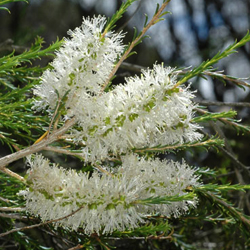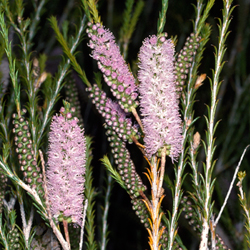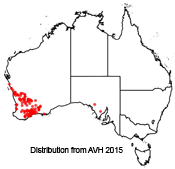Melaleuca hamulosa
 |
 |
Melaleuca hamulosa is a member of the family of Myrtaceae. It is a large, bushy, broom-like shrub and tree 3-6m high with numerous ascending branches. It grows wild in Western Australia around the Eneabba district south of the Stirling Ranges and east to the Southern Cross and Ravensthorpe districts. M. hamulosa is an adaptable species and grows in most soils, including sandy soils, clay soil, winter-wet flats, saline depressions, swamps and granite outcrops.
Its bark is rough papery and glabrous while the young shoots are covered in downy hairs. It has small ovate leaves spirally arranged with a pronounced hook at apex. It usually flowers in late spring or early summer with white or pinkish mauve flowers in spikes 2 to 5 cm long.
Melaleuca hamulosa can be grown from both seed and from cuttings. Seeds require no treatment before sowing. Seed is easy to collect and is best collected from fruit capsules which are 1 to 2 years old. After collecting seed, they can be placed into a non-airtight container. Sow thinly. Germination takes place in approximately 14 days. Leave it in the nursey for some months until it is ready then plant it out in the garden. The common problem with seed planting is fungal disease. It can also be grown from fresh semi hard wood cuttings taken in December to March. Remove excess leaves and trim few remaining leaves from the cutting. Use a rooting hormone such as Clonax gel purple 2000/IBA to establish cutting and put in a pot containing propagation mix. The cutting takes 6-7 weeks before roots form. Plant out in full sun to part shade. Plants grown from cuttings usually give flowers fairly quickly. M. hamulosa is low maintenance and you can manage shape and size with regular light pruning. It is an excellent garden plant which withstands both wet and long dry spells.
Alu Kaiye, Botanical Intern 2015
Name meaning: Melaleuca hamulosaMelaleuca - derived from Greek root words melas, meaning black, which refers to the trunks when blackened by fire, and leucos, meaning white, which refers to the white-barked upper branches of some species hamulosa - Greek, meaning a small hook or hook-like, which refers to the hooked leaf apex of this species |
References:
Holliday, I.(2004) Melaleucas: A Field and Garden Guide, Reed New Holland Publishers, Australia Pty Ltd.
Cowley, K.J., Quinn, F.C., Barlow, B.A. & Craven, L.A. (1990) Contributions to a Revision of Melaleuca (Myrtaceae): 7 – 10, Australian Systematic Botany 3:165-202.
R. Uwedo-Hampshire (2015) ANBG Horticulturalist, Personal Communication.
Western Australian Herbarium (1998–). FloraBase—the Western Australian Flora. Department of Parks and Wildlife. Available at https://florabase.dpaw.wa.gov.au/ [Accessed Feb 2015].
![An Australian Government Initiative [logo]](/images/austgovt_brown_90px.gif)


